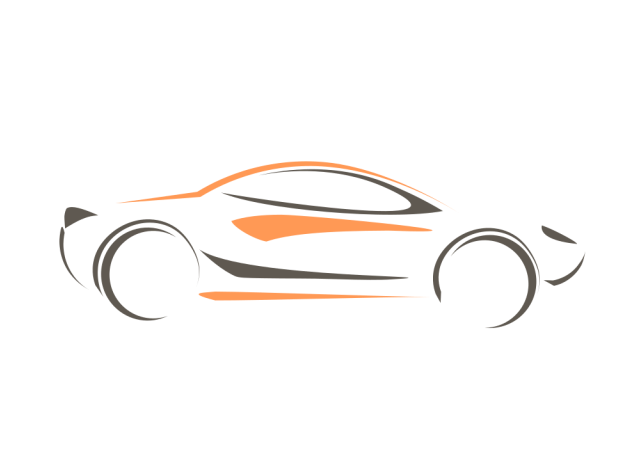About Paolo Martin
Paolo Martin was born in Turin, Italy, on 7th May 1943. His first professional experience was at Studio Tecnico Michelotti (1960).
He then worked for some of the most important Turinese designers: Bertone (July 1967), Pininfarina (July 1968) and De Tomaso Group (January 1972), where he was Ghia‘s Style Center Director (1973-1976).
Since 1976 he’s been working as a freelance designer, running a Studio which offers design consultancy and styling models construction services.
His current customers include Fiat, Nissan, BMW, Subaru, Piaggio, Gilera, Ferretti Kraft, Cigarette, Magum Marine, Dassault Aviation and others.
Dodge Copperhead
Production cost: $30,000*
The Dodge Copperhead was a close relative to the Dodge Viper but never made it to the main streets. The Copperhead had its own interior design that differed from the Viper but maintained some nuances from its well-known cousin. It had a V-6 engine and was slated to be a more affordable version than the Viper.
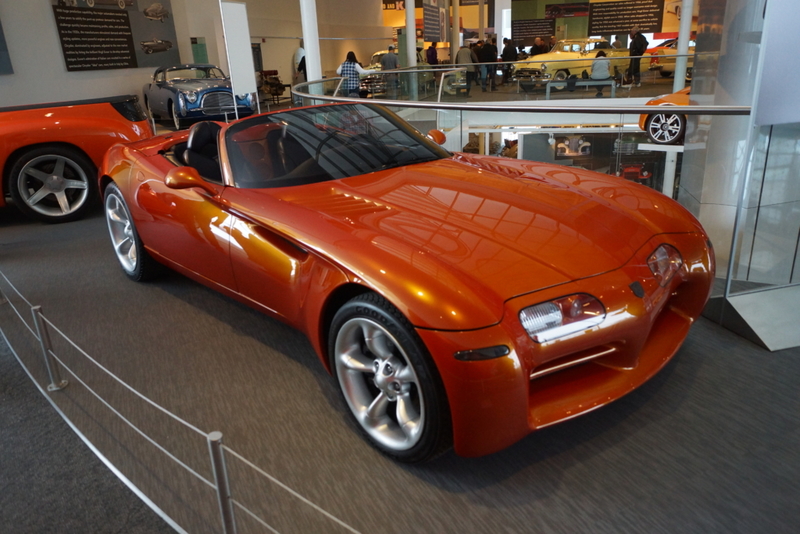 Flickr Photo By Greg Gjerdingen
Flickr Photo By Greg Gjerdingen
The Copperhead was marketed to the driving enthusiast with its low-profile that allowed the driver to feel closer to the road. It was almost released in 2000 until the market demand for SUVs pushed the Copperhead out of the manufacturer’s minds.
Nissan Pivo
Production cost: $200,000*
The Nissan Pivo was a lithium-ion battery-powered vehicle designed with environmental conservation in mind. It made its public appearance in 2005 at the Tokyo Motor Show. The vehicle sported large doors, windows, windscreens, and A-pillars on either side of its windshield. The Pivo came with the Around View Monitor System, a project developed by Nissan that helps reduce blind spots.
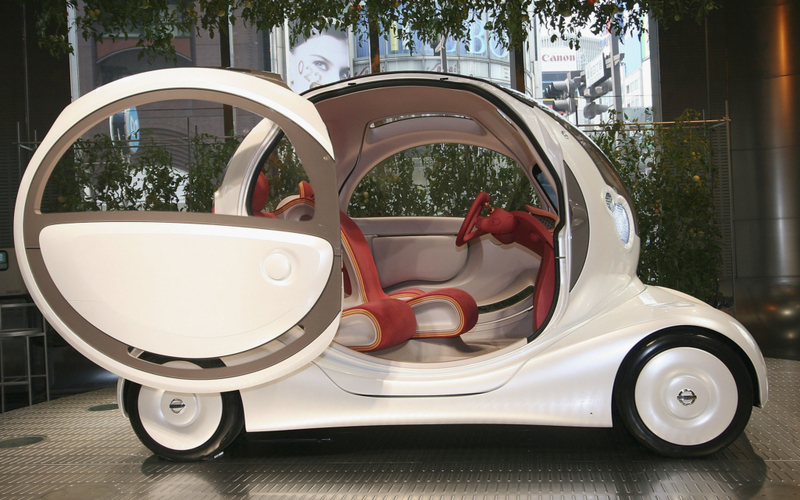 Getty Images Photo by Koichi Kamoshida
Getty Images Photo by Koichi Kamoshida
The Pivo’s most remarkable feature was that it could rotate 360 degrees. The three-seater cabin had a chassis with four wheels, so there would be no need for reversing, as you could just spin around. Parking would also be a breeze with the Pivo, as it had three iterations.
Bisiluro Damolnar
Production cost: $20,000*
The Bisiluro Damolnar was a rather quirky-looking, twin-boom, a missile-like car with an oval-shaped steering wheel. Conceptualized by racer Enrico Nardi, he used a BMW, Giannin-tuned 750 engine for one side of the vehicle in its manufacturing. The other side of the vehicle featured the driver’s seat, and both the driver and engine were kept in their own streamlined capsules.
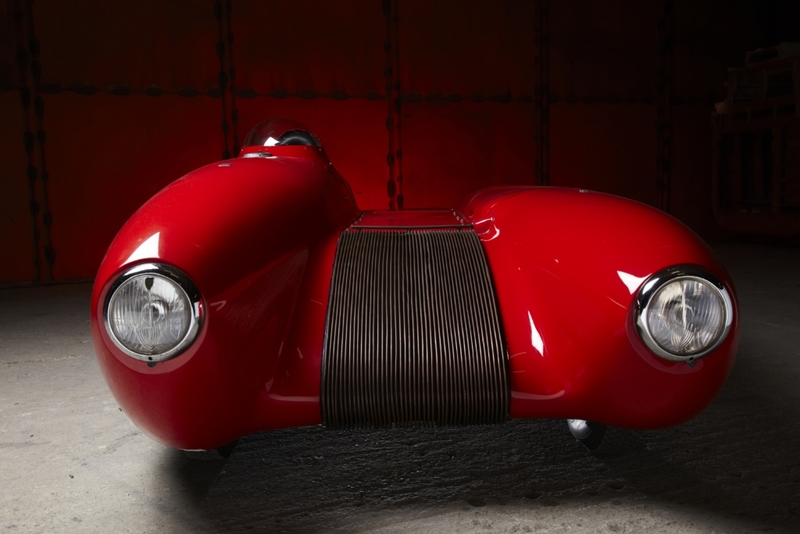 Getty Images Photo by DEA / MUST
Getty Images Photo by DEA / MUST
The cherry-red racer weighed under 1,000 pounds and was positioned on a Fiat 500 chassis. The Bisiluro Damolnar debuted in 1955 at the Le Mans running but was found to be unsuitable for the road due to its lightness.
История
До 1967 года Ferrari выпускала прототипы с рабочим объемом четыре литра (см. Ferrari P), но из-за высоких скоростей, достигнутых в Ле-Мане на этих автомобилях, а также на Ford GT40 с семилитровым двигателем V8, правила были изменены на 1968. прототипы группы 6 пильных их перемещения ограничена до 3 литров , как в Формуле 1. Несмотря на то, с соответствующим двигателем Ferrari выбирает , чтобы нарисовать линию под сезоном 1968 года , чтобы вернуться в 1969 году с Ferrari 312 P . В том году Porsche воспользовалась лазейкой в правилах с Porsche 917 и пошла на риск, построив двадцать пять экземпляров 5-литрового автомобиля, чтобы разрешить его омологацию в Группе 5, определяемой FIA как спортивный автомобиль. категория автомобиля. Воспользовавшись продажей половины своей компании Fiat , Энцо Феррари собрал необходимые средства, чтобы составить конкуренцию Porsche. Ferrari намеревалась продать излишки автомобилей командам клиентов, что означало, что было доступно несколько десятков очень мощных автомобилей. Каждый из них требовал двух пилотов для гонки на выносливость, не хватало опытных пилотов.
Двигатель 5123 был полностью новым 560 л.с. (404 кВт) 60 ° V12. По сравнению с 12-цилиндровым плоским двигателем Porsche с воздушным охлаждением, для этого требовалось большое количество охлаждающих трубок и огромный радиатор. Поскольку шасси было изготовлено из стальных труб с приклепанными алюминиевыми панелями, автомобиль весил на 100 кг больше, чем шасси с алюминиевой рамой 917. Несмотря на разницу в весе и более высокий центр тяжести, автомобиль весил более 100 кг. Ferrari 512S и Porsche 917 должны теоретически вести сбалансированный поединок.
В начале 1970-х Ferrari 512S пострадали от предсказуемых детских болезней, включая плохую подвеску и проблемы с трансмиссией. Тот факт, что Porsche уже накопил в 1969 году шесть месяцев контрастного опыта с 917, окажется решающим на оставшуюся часть сезона. В отличие от Porsche, Ferrari не организовывала внутренних соревнований. В Porsche, John Wyer Automotive, KG Porsche Salzburg и позже Martini Racing получили прямую заводскую поддержку. Таким образом, по крайней мере четыре машины были настоящими заводскими машинами, но без давления на сам завод, поскольку средства и персонал были предоставлены этими профессиональными командами. И даже частные компании, такие как AAW Shell Racing и David Piper Racing, получили гораздо лучшую поддержку, чем клиенты Ferrari. Ferrari не приняла эту современную схему, но сама вошла в автомобили традиционным способом под знаменем Spa Ferrari SEFAC . Поскольку в предыдущие годы по контракту было всего несколько пилотов Формулы-1, а также с лучшими гонщиками спортивных автомобилей, выступающих за Porsche, Ferrari изо всех сил пыталась найти пилотов, способных выполнять свои обязательства. Помимо заводских автомобилей, были представлены частные автомобили Scuderia Filipinetti , NART , Écurie Francorchamps , Scuderia Picchio Rosso, Gelo Racing Team и Montjuich stable. Эти частные автомобили никогда не получали поддержки, эквивалентной той, которую Porsche оказывает своим клиентам. Их считали конкурентами, которым суждено завершить стартовую решетку, но не кандидатами на победу.
В конце сезона 1970 года Ferrari выиграла « 12 часов Себринга», в то время как Porsche 917 и разделили победу в других девяти гонках чемпионата. В Ле-Мане у Ferrari возникли проблемы с надежностью, хотя они считались такими же быстрыми, как и 917. Четыре 512S были заявлены Ferrari на гонку, но тот, что находился в руках экипажа Ваккареллы / Джунти, был удален после семи поворотов. Автомобиль, которым управляла пара Мерцарио / Регаццони, не проехал дальше тридцать восьмого круга, а автомобиль Белла / Петерсона сошел с дистанции кругом позже. Примерно через пять часов автомобиль, которым управлял Иккс / Шетти, выбыл после 142 кругов. На быстрых трассах, таких как Ле-Ман , Спа , Монца и Österreichring , к автомобилю была прикреплена длинная задняя часть (длинный хвост), предназначенная для лучшего соответствия скоростным трассам. К концу сезона 512M оказались быстрыми, и команда Икса / Джунти также выиграла Springbok 9 Hours на трассе Кьялами, вне чемпионата. Поскольку лазейка в правилах должна была быть закрыта после 1971 года, Ferrari решила больше не входить в 512 конкурирующих заводов, чтобы сосредоточиться на разработке нового трехлитрового прототипа. В 1971 году команда Penske представила улучшенный 512M (шасси № 1040) в ливрее Sunoco, который смог конкурировать с 917, несколько раз занимая поул-позицию.
Chevrolet Astro III
Production cost: $4,000*
The Chevrolet Astro III first turned heads at the Chicago Motor Show in 1969. The design was a sort of hybrid between a plane and automobile. It held a Type 250-C18 gas engine, which was manufactured by General Motors’ Allison Division. The gas turbine engine weighed just 139 pounds and got 317 horsepower. An interesting fact about the gas turbine engine is that it was produced to propel military and civilian helicopters!
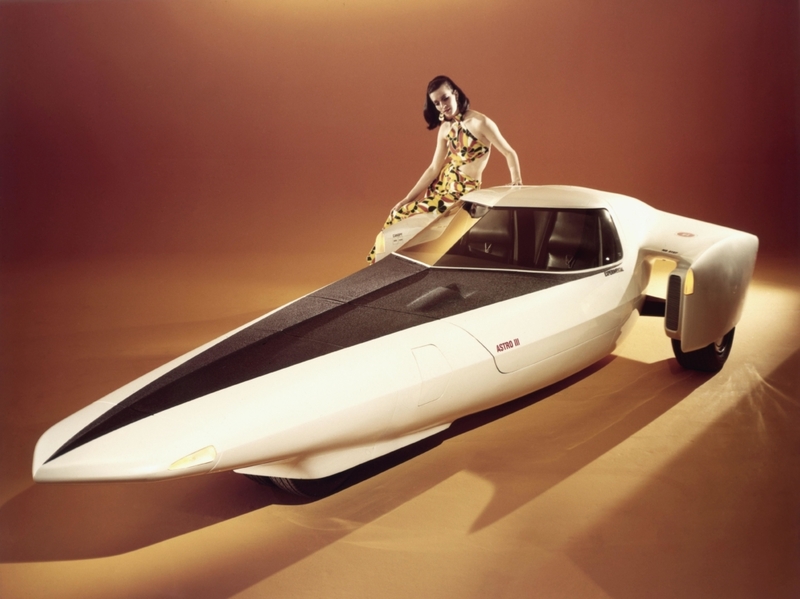 Alamy Stock Photo
Alamy Stock Photo
The two-passenger, three-wheeled vehicle would have been unlike anything else on the road as it was designed to be a high-performance car that would only travel on restricted-access highways. Though it was an eye-popping design, the Chevy Astro III was just an experiment.
Frisky Family Three
Production cost: $400*
With a unique and spunky model name, Meadows Frisky was a series of small cars manufactured between 1958 and 1961 in England by Henry Meadows. The Frisky Family Three was a compact, three-wheeled concept version of a smaller British car (designed by Giovanni Michelotti).
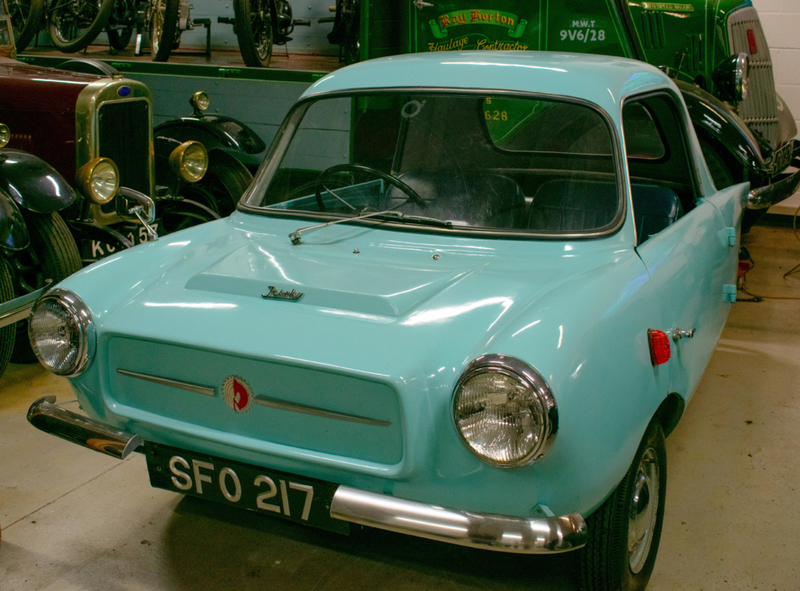 Alamy Stock Photo
Alamy Stock Photo
The adorable car was produced in August of 1958 and debuted at the Earls Court Motor Show in 1958. It featured a smaller 9E Villiers engine, along with a MacPherson strut front suspension. Though it gave the car a strange look, the three wheels meant that the vehicle had a lower excise duty. Nearly a hybrid vehicle, you could also drive it with only a motorcycle license.
Гоночная история[править | править код]
1970 год
В первой гонке сезона 24 часа Дайтоны участвовало пять Ferrari 512 S. Лишь одному экипажу, пилотируемому Марио Андретти, Артуро Мерцарио и Жаки Иксом, удалось завершить гонку выйдя на третье место позади двух Porsche 917.
21 марта состоялась 12 часовая гонка Сербинга на которой приняло участие четыре Ferrari 512 S. Один из них, пилотируемый Иньяцио Джунти и Нино Ваккарелла, занял первое место. Остальные три Ferrari 512 S не смогли добрать до финиша.
На гонке 1000 км Брэндс-Хэтча Ferrari 512 S, пилотируемый Крисом Эймонсом и Артуро Мерцарио, пришел пятым. Первые три места оставили за собой Porsche 917, а четвертое занял Porsche 908.
На гонке 1000 км в Монце победа была завоевана Porsche 917, тогда как Ferrari 512 S прибыли на вторую, третью и четвертую позиции. Кроме того еще два Ferrari 512 S заняли восьмое и девятое место.
На гонке 1000 км Спа Porsche 917 снова завоевал первое и третье место. Ferrari 512 S сумел занять второе и четвертое место.
На 1000 км Нюрбургринга Ferrari 512 S занял третье и четвертое место.
На гонке 24 часа Ле-Мана Porsche завоевал первые три позиции, с двумя и . Ferrari 512 S заняли четвертую и пятую позицию.
В 6 часовой гонке Уоткинс Глен Ferrari 512 S, пилотируемый Марио Андретти и Иньяцо Джунти, занял третье место. Porsche 917 занял второе место.
Последней гонкой сезона стала 1000 км Цельтвег. Ferrari 512 S занял лишь седьмое место. В этой гонке также дебютировал новый Ferrari 512 M, но его пришлось снять из-за проблем с проводкой.
1971 год
Ferrari 512 M не удалось выиграть ни одной гонки на чемпионате мира. Успех для Ferrari 512 M пришел на гонке 2 мая на автодроме Энцо и Дино Феррари, проходившей в рамках чемпионата Interserie.
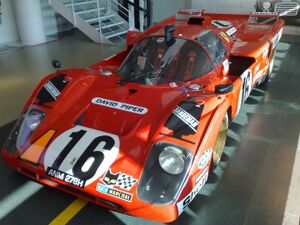
Ferrari 512 М в Галерее Феррари в Маранелло
About the Ferrari Modulo
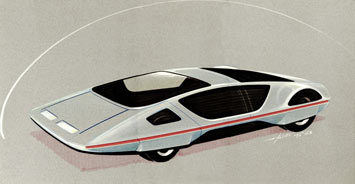 Although presented at the Geneva Motor Show in 1970, the Ferrari Modulo had been designed in 1968 by Paolo Martin and then kept aside for more than one year.
Although presented at the Geneva Motor Show in 1970, the Ferrari Modulo had been designed in 1968 by Paolo Martin and then kept aside for more than one year.
In addition to the original drawings, Paolo Martin created a full-scale polystyrene model in August 1968.
The Modulo project was conveived in “a corner of the drafting table” in a few-minutes span, and for some time it was looked at with distrust by Pininfarina’s management, eventually becoming a milestone in the automobile design history with a deep influence on the 1970’s car styling.
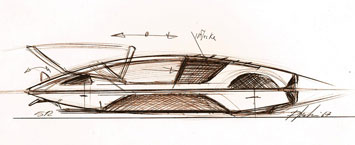 The Ferrari Modulo was displayed all over the world: Osaka, Montreal, New York, where it was awarded the best design prize by Automobile Quarterly, Los Angeles, where it received the 1972 Auto Expo Star award, until the 1984 Turin Motor Show, when it still fascinated young people from the new generation.
The Ferrari Modulo was displayed all over the world: Osaka, Montreal, New York, where it was awarded the best design prize by Automobile Quarterly, Los Angeles, where it received the 1972 Auto Expo Star award, until the 1984 Turin Motor Show, when it still fascinated young people from the new generation.
Below we report the exclusive story, narrated by Paolo Martin himself.
2014 Infiniti Q50 Eau Rouge
Production cost: $100,000*
At first glance, the Q50 Rogue may appear to be an unassuming sedan, but it is full of surprises. Modeled after the Q50 sports sedan, the Eau Rouge has some discreet racing features along with many custom features too such as a custom carbon fiber roof and dual-exhaust system. One of the most unique elements of the Eau Rouge is its deep red hue.
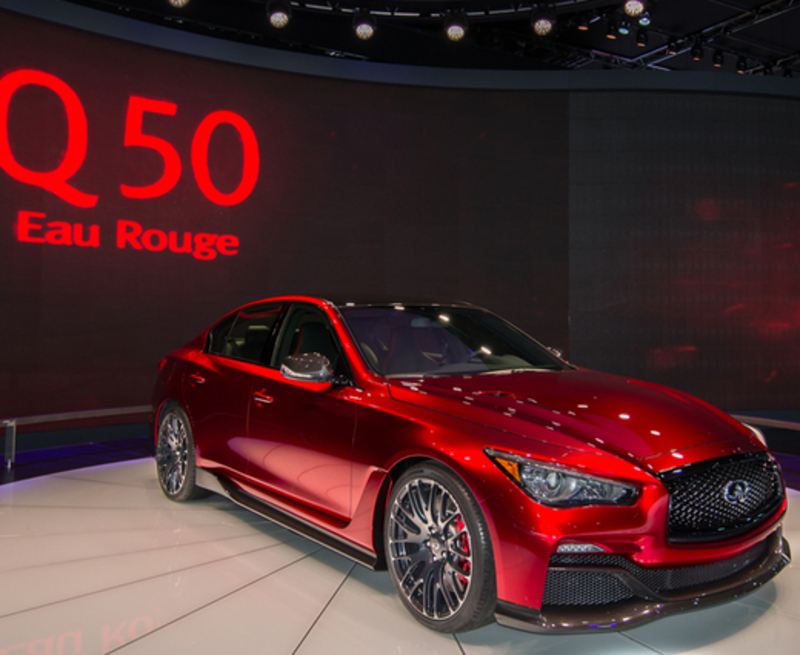 Shutterstock
Shutterstock
The car’s paint was created with a red-infused clear coat resulting in an extraordinary red color. But you’ll have to save that illustrious red for your dreams, because this model too, never made it to mass production.
Dymaxion
Production cost: $7,688*
The Chicago World’s Fair was a great place to debut cutting-edge ideas and inventions. And at the Chicago World’s Fair in 1933, the Dymaxion car made its debut. Conceptualized by American inventor Bucky Fuller and Starling Burgess, the car was designed to fly and drive. Fuller used money from his family inheritance and donations from the public, to develop the concept car.
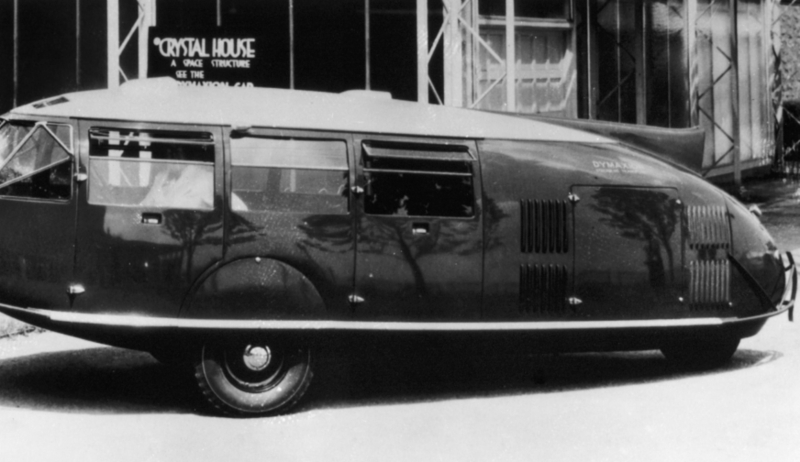 Alamy Stock Photo
Alamy Stock Photo
The word “Dymaxion” originated from a combination of the words dynamic, maximum, and tension. The Dymaxion’s transmission and engine (a flathead Ford V8) were both made by Ford.
Buick Y-Job
Production cost: $109,000*
The Buick Y-Job is unique in that it is considered to be the very first concept car. The Y-Job was a convertible with two-doors and a 5.2-liter Buick straight-eight engine. It also had a wheelbase of 126 inches and was designed by Harley Earl. In addition, it had sleek, discrete features like hidden, power-operated hood lamps and electric windows (which were quite avant-garde at the time).
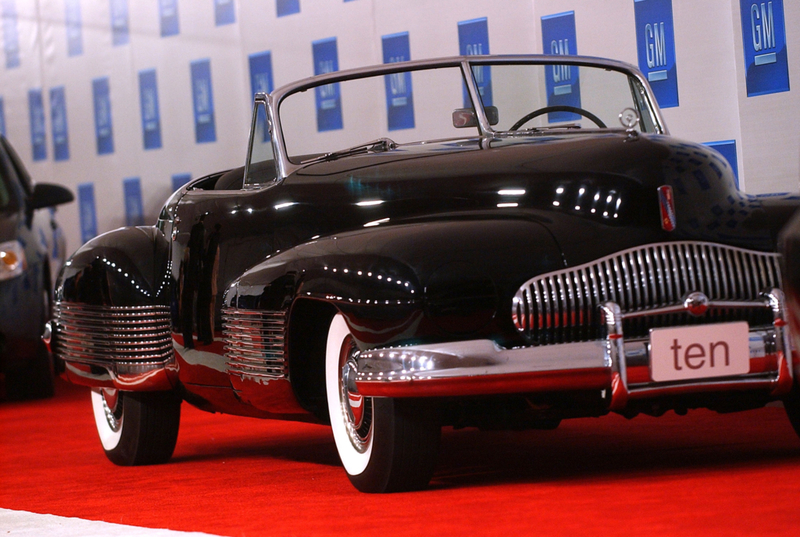 Getty Images Photo by Dimitrios Kambouris/WireImage for Bragman Nyman Cafarelli
Getty Images Photo by Dimitrios Kambouris/WireImage for Bragman Nyman Cafarelli
The Y-Job displayed a gunsight hood ornament, flush door handles, and wrap-around bumpers. Though it sadly wasn’t mass-produced the Y-Job had design features that are still used by car manufacturers today, such as the vertical waterfall grille.
Dome Zero
Production cost: $30,000-$60,000*
With its super wedge design and pop-up headlights, the Japanese-made Dome Zero could not be missed. Taking inspiration from the original Japanese race car, race car creator Minoru Hiyashi wanted to bring all of the speed and flashiness of the track to everyday life.
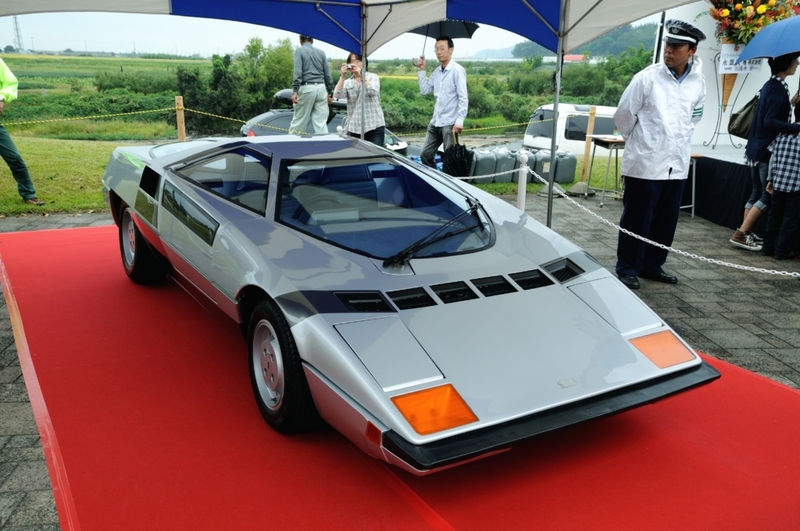 Flickr Photo By contri
Flickr Photo By contri
The Dome Zero had a 2.8 liter inline-6 that yielded 142 horsepower. It could reach speeds of up to 163 miles per hour and had head-turning, gull-wing doors. Though it was beloved by the public, the designers of the Dome Zero could not reach homologation requirements or get the funding needed for the concept.
История создания[править | править код]
В октябре 1967 года C.S.I. объявила об очередном изменении регламента Чемпионата Мира по гонкам на спортивных автомобилях. Рабочий объём моторов автомобилей класса Prototype, в котором до сих пор выступали наиболее успешные автомобили Ferrari, был ограничен 3 литрами. Рабочий объём автомобилей класса GT был ограничен 5 литрами при гарантированном объёме выпуска в не менее чем 50 автомобилей. Гоночный автомобиль Ferrari 312P (Prototype) оказался не слишком удачным. Но на сезон 1969 года минимальное ограничение в 50 автомобилей для GT ввиду низкой заинтересованности производителей было пересмотрено в сторону уменьшения до 25 автомобилей, что и сподвигло Ferrari на разработку и выпуск ограниченной серии Ferrari 512S, фактически ставшей эволюцией штучных 312P.
Dodge Deora
Production cost: $324,500*
Brothers Mike and Larry Alexander, commissioned the design for the Dodge Deora from Harry Bradley. The car was designed in 1965 and was assembled for two years before its debut in the 1967 Detroit Autorama. The Deora’s design was based on a 1965 A100 Dodge pickup truck that the Alexander brothers customized for their purposes.
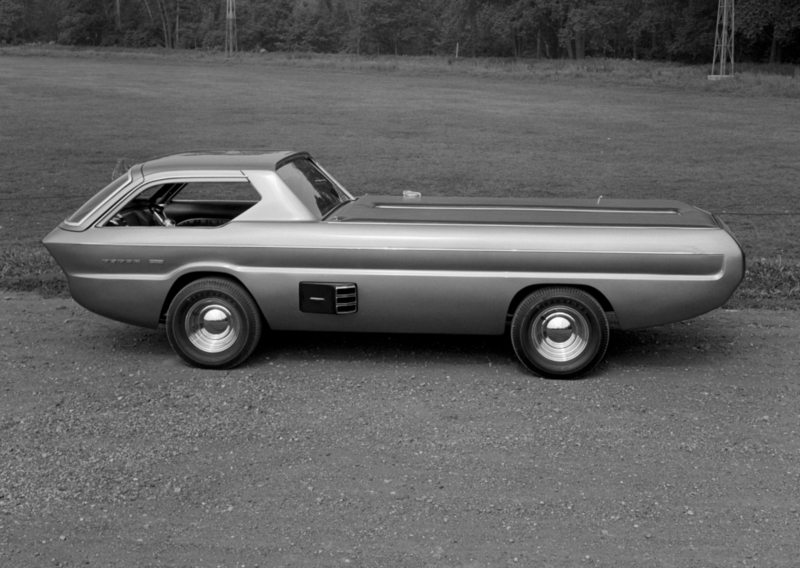 Getty Images Photo by Spence Murray/The Enthusiast Network
Getty Images Photo by Spence Murray/The Enthusiast Network
One of the special highlights of the car was the 101 horsepower engine and three-speed manual transmission. The Deora ended up being quite a hit and won nine awards at the Autorama, including the vaunted Ridler Award. The gold truck was even transformed into a Hot Wheels car.
Aurora Safety Car
Production cost: $30,000*
A curious fact about the Aurora Safety Car was that it was actually created by a Catholic Priest! It was also the first safety concept vehicle ever created. Father Alfred Juliano, used church donations to fund the prototype, which at $30,000 was more expensive than the actual car (which was priced at $12,000-$13,000).
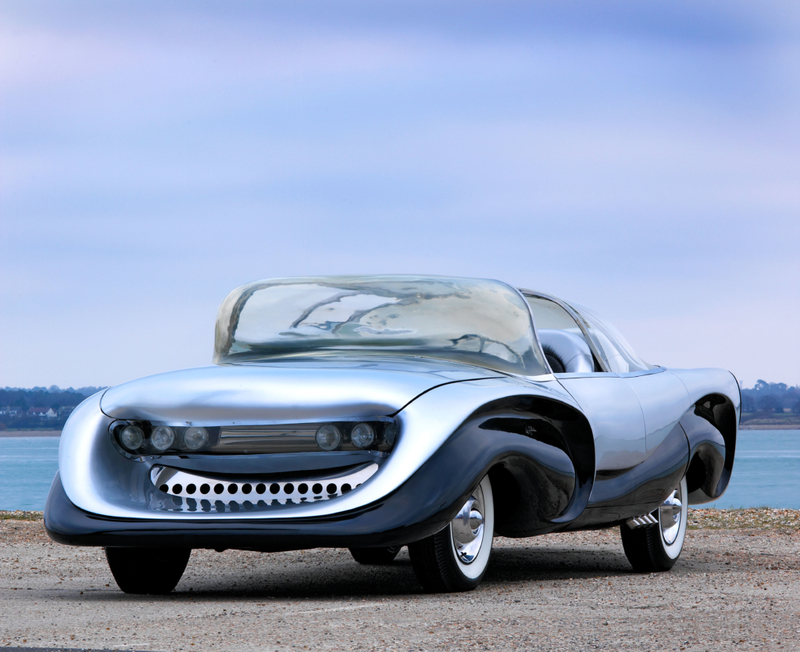 Alamy Stock Photo
Alamy Stock Photo
The Safety Car was made of fiberglass and built on a ’53 Buick chassis. The car was named a “safety” car because it came with seatbelts (not seen in most cars at the time), a padded instrument panel, a collapsible steering column, and a roll cage. The most novel feature about the car was that it was designed to absorb impacts. In fact, the seats would swivel and face rearwards during a collision.
Toyota EX-III Concept Car
Production cost: $2,000*
The EX-III was the third production in a collection of Toyota concept cars. The prime signature of the EX-III’s design was its aerodynamic ability, which was greatly emphasized when it was displayed. The EX-III had room for two and appeared to the public at the Tokyo Motor Show.
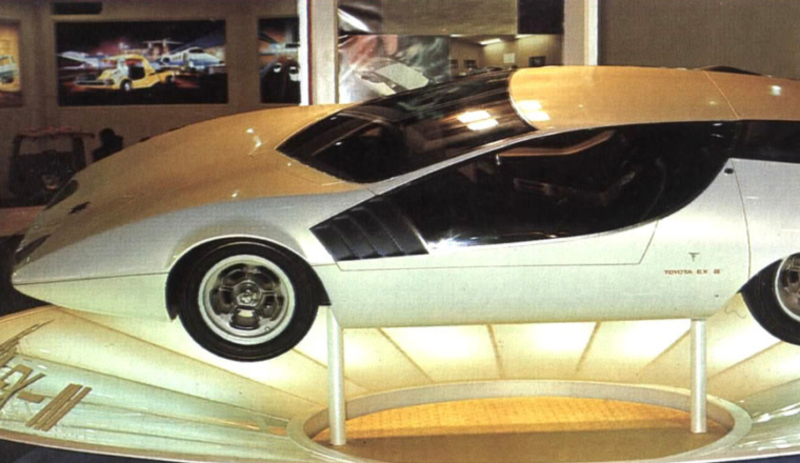 Imgur.com/oxdyfYZ
Imgur.com/oxdyfYZ
The roof-mounted spoiler was adjustable in order to increase and maintain stability even at high speeds. The interior was designed with convenience in mind with all of the controls within reach. With a longer bonnet, lower build, tapered rear, and sharp, sloped sides, the EX-III was a head-turning model.
Lincoln Futura
Production cost: $250,000*
The Lincoln Futura was a very expensive design to make (for 1955) as it took $250,000. Today that’s the equivalent of $2.4 million! The Futura first appeared at the Chicago Auto Show and later on the Today Show (then called Today) in March of 1955. The car’s design featured a plastic clear canopy top, large headlight pods, and giant tailfins—all novel features in the fifties.
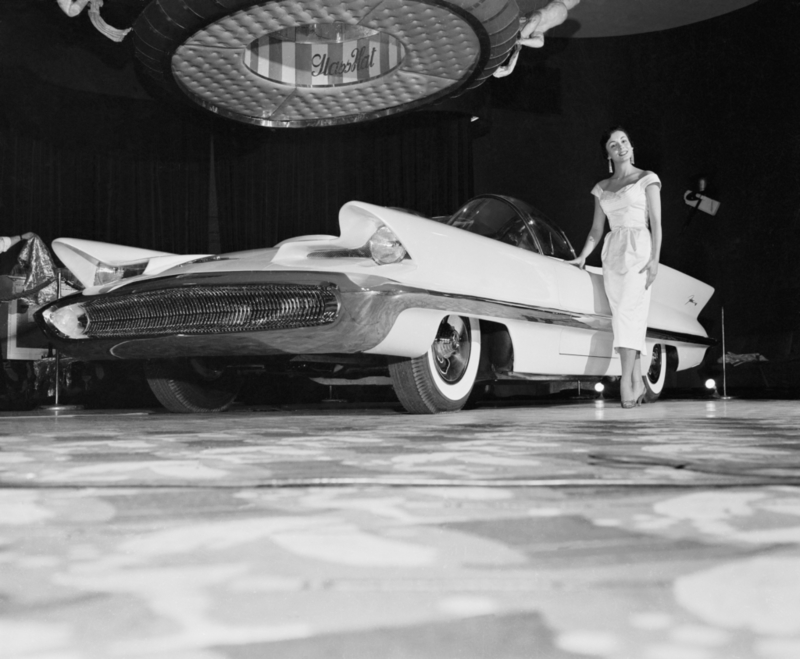 Getty Images Photo by Bettmann
Getty Images Photo by Bettmann
The Futura was showcased within the auto show circuit throughout the mid-fifties before it became an icon as the base design for the Batmobile. George Barris customized the Futura’s design for the ’66 TV series.
Alfa Romeo BAT 5
Production cost: $5 million*
Italian-made cars are known to make a statement both on the race track and on the city streets. Bertone-Alfa Romeo launched a series of aerodynamic vehicles called the BAT project. Manufacturers studied and applied aerodynamic principles in the design in order to create the BAT 5.
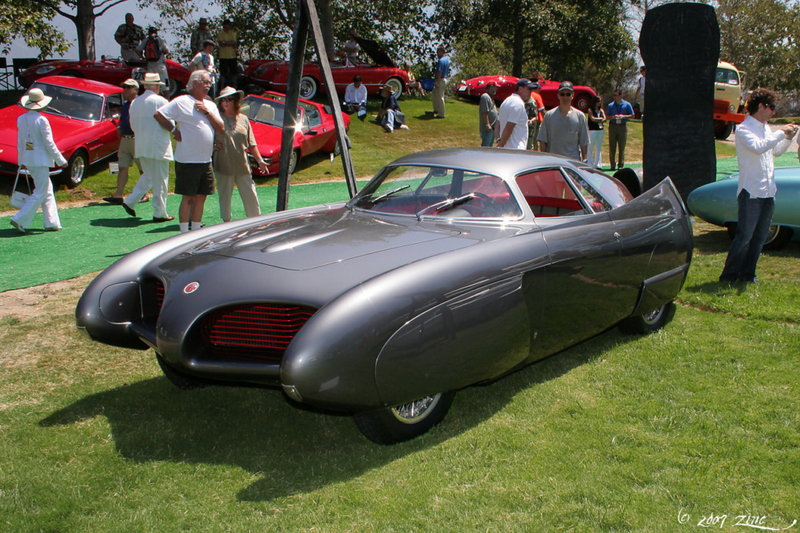 Flickr Photo By Rex Gray
Flickr Photo By Rex Gray
The front shape of the BAT 5 was designed to eliminate wind resistance and airflow disruption. Taking the laws of physics into mind in the BAT 5’s design allowed it to reach speeds of 120 miles per hour! Bertone designed the BAT 5 to be very light, weighing just 2,400 pounds while the engine was mounted as a standard, getting 100 horsepower. The windscreen and body of the car blended into the roof, which was almost flat, giving it the shape of a bullet.
Phantom Corsair
Production cost: $24,000*
The Phantom Corsair first turned heads in the famous movie, «Young At Heart,» a 1938 David Selznick movie. The Corsair had sleek, futuristic features that placed it far ahead of its time. It had fared-in fenders, a low vehicle profile, and sleek black paint. This two-door sedan could fit all your friends with room for six people! The designer was Rust Heinz who was a part of the H.J. Heinz family.
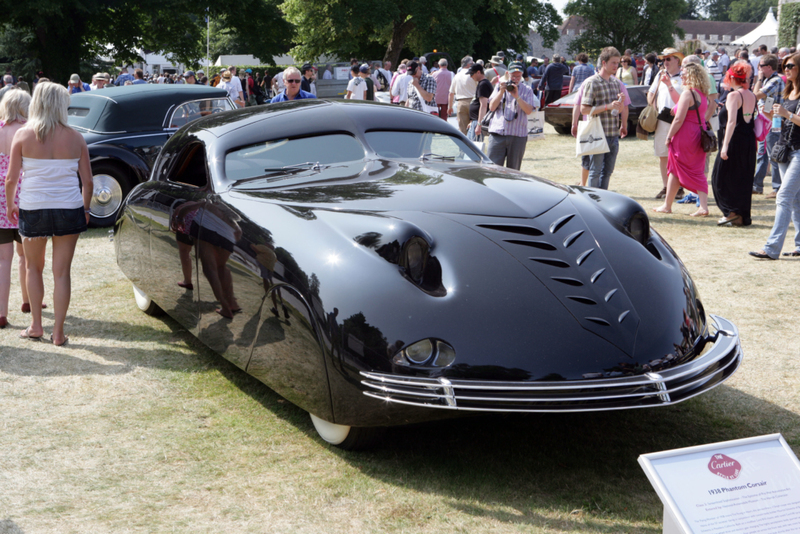 Alamy Stock Photo
Alamy Stock Photo
On the road, the Corsair could reach speeds of up to 115 miles per hour because of its aerodynamic shape and a naturally-aspirated, Lycoming V8 80-degree engine that yielded 125 horsepower. And if all of that time on the road made you a bit thirsty, there were also beverage cabinets on-board in the backseat.
Построенных машин
Майк Паркс на Ferrari 512 (шасси 1008) Scuderia Filipinetti до 1000 километров от Нюрбургринга в 1970 году, где он финишировал 4- м с Гербертом Мюллером.
Ferrari 512M (шасси 1044) Герберта Мюллера, 1971 год на Нюрбургринге
Ferrari представила требуемое количество 25 автомобилей отделам омологации — семнадцать готовых и восемь в сборке — как раз к 24 часам Daytona. Среди этих автомобилей, шасси которых, согласно традиции, имело четные числа от 1002 до 1050, в 1970 году в гонках использовалось девятнадцать, включая пять «пауков». В отличие от Porsche, который построил в общей сложности пятьдесят 917s, Ferrari не удалось продать все излишки автомобилей и шасси 1046 был дан Pininfarina , который использовал его для создания концепт — кар , в Ferrari Modulo .
Единственные 512 шасси, которые выиграли всемирно известные гонки в 1970 году, были 1026 (Sebring) и 1010 (Kyalami, но уже в версии M и за пределами WSC в конце сезона).
Из двадцати пяти автомобилей, изготовленных для сезона 1970 года, но не участвовавших в гонках в том году, шасси 1020 было преобразовано в 512M в конце сезона и продано NART, которая участвовала в соревнованиях в 1971 году. 1024 шасси остались. непроданный в 1970 году и был преобразован в 512M, который в следующем году был продан компании Scuderia Brescia Corse. Шасси 1036 использовалось гоночным отделом Ferrari в качестве тестовой машины. Позже он был продан Solar Productions для использования в фильме « Ле-Ман» со Стивом МакКуином .
Peugeot Moovie Concept Car
Production cost: $50,000*
In 2005 Andre Costa, a designer from Portugal, created the sleek, environmentally-friendly “Moovie Car.” Costa won a design concept with his scale-one concept car, which he had dubbed “The Moovie”. He manufactured it at the Peugeot Style Centre in keeping with the design rules. It took three months, from conceptualization to final model, to end up on the showroom floor.
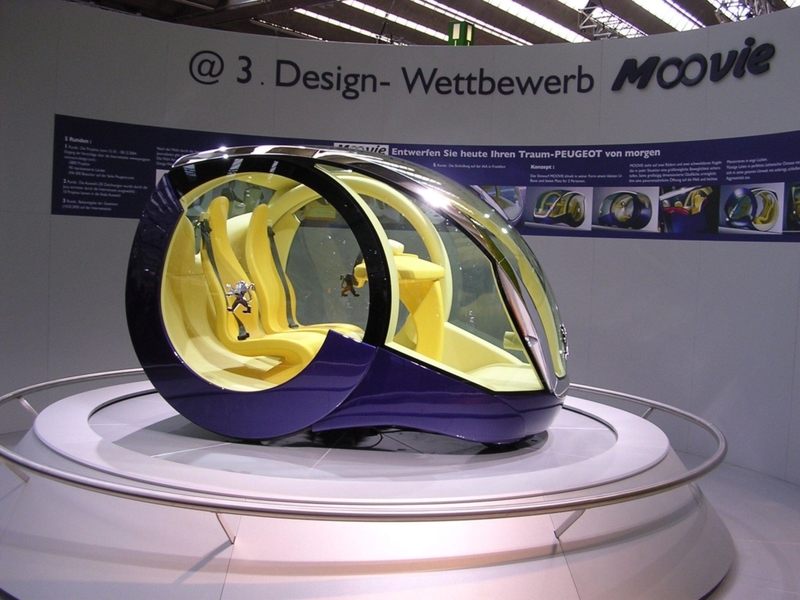 Alamy Stock Photo
Alamy Stock Photo
The two-passenger vehicle featured a weight of 1,102 pounds and was 60.6 inches in height and 91.7 inches in length. The Moovie was 70.9 inches wide and made its appearance at the Frankfurt Motor Show.
Honda Fuya-Jo Concept Car
Production cost: $20,000*
The sharp-edged, Blade-runner inspired Fuya-Jo debuted in 1999, and was part of the F-Mover series. It was designed to be driven in a city environment and represented what the Japanese designers thought would be the future of inter-city transportation. The vehicle seated four people and had a high silhouette.
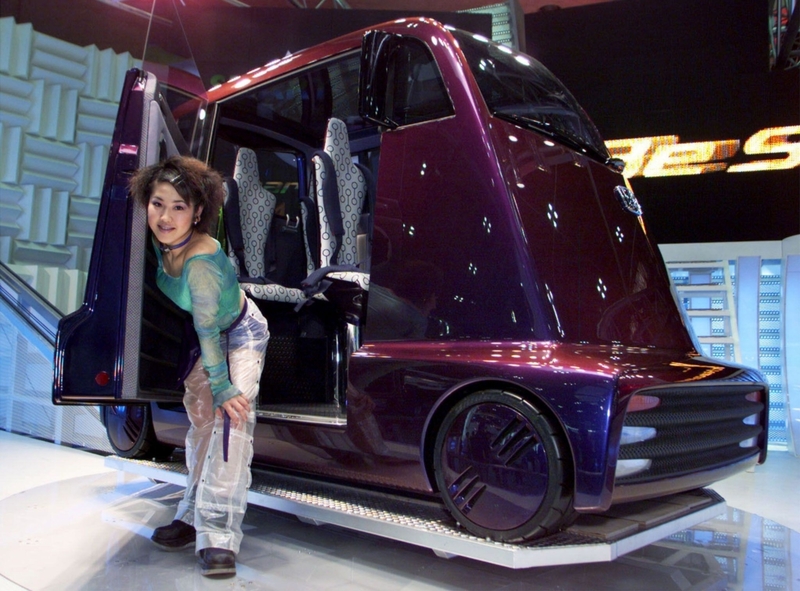 Alamy Stock Photo
Alamy Stock Photo
The name Fuya-Jo’s meant “Sleepless City” and really turned heads with its purple exterior at the Tokyo Motor Show. Definitely catering to those with eccentric tastes, the steering wheel and dashboard were designed to resemble a DJ’s mixing booth. Fuya-Jo continued to debut at auto shows till 2002 but was never allowed for public consumers.
BMW LOVOS
Production cost: $200,000*
The BMW Lovos was a student design project turned public concept car. Anne Forschner, a German design student developed the solar-powered car model. The word “Lovos” stands for Lifestyle of Voluntary Simplicity and contains 260 interchangeable, identical, and movable photovoltaic exterior plates that resemble fish scales in their design.
 Flickr Photo By mompl
Flickr Photo By mompl
The car’s parts produce a voltage when they are exposed to sunlight and twelve of the plates collapse and form turbines when the vehicle is put into motion. Its exterior design is certainly not for everyone’s taste, but the inside is made to be comfortable.
Buick Avista
Production cost: $84,035*
The Buick Avista was a breath of fresh air from the brand known for its girth and durability that dominated its style. With the Camaro’s Alpha platform as its foundation, the Avista was conceptualized by Ed Welburn and featured twin-turbo V-6 engines. And though it was very stylish, the Avista was more than just looks.
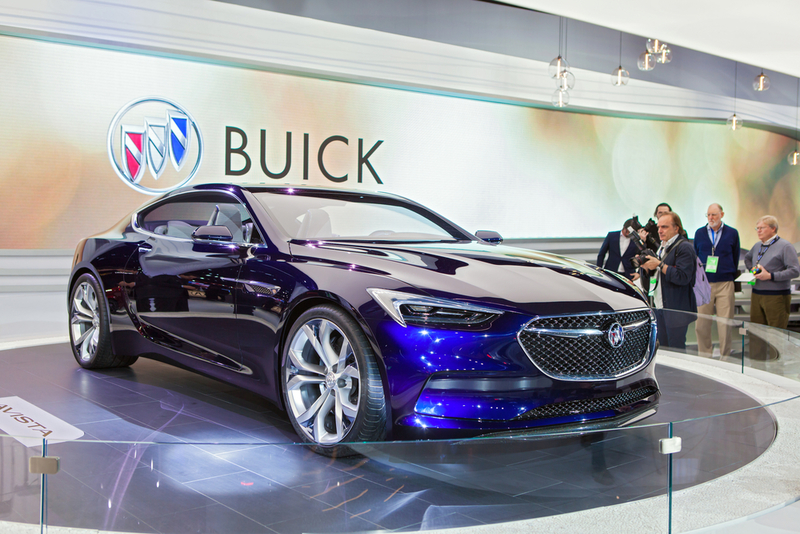 Shutterstock
Shutterstock
The concept had Magnetic Ride Control which allowed for smooth steering on the road and with 400 horsepower, it was quite the novelty for this car manufacturer. However, Buick insisted on retaining the Avista solely for design research.
Plymouth XNR
Production cost: $935,000*
The Plymouth XNR design was a team effort by Chrysler and Plymouth in 1960 to develop a sports roadster. Virgil Exner conceptualized the two-door vehicle in an effort to add it to the Plymouth family. The XNR roadster was thought to be a potential competitor to the Chevy Corvette or Ford Falcon. It was finally created after Chrysler’s sales dropped, which caused Chrysler to reexamine their brand.
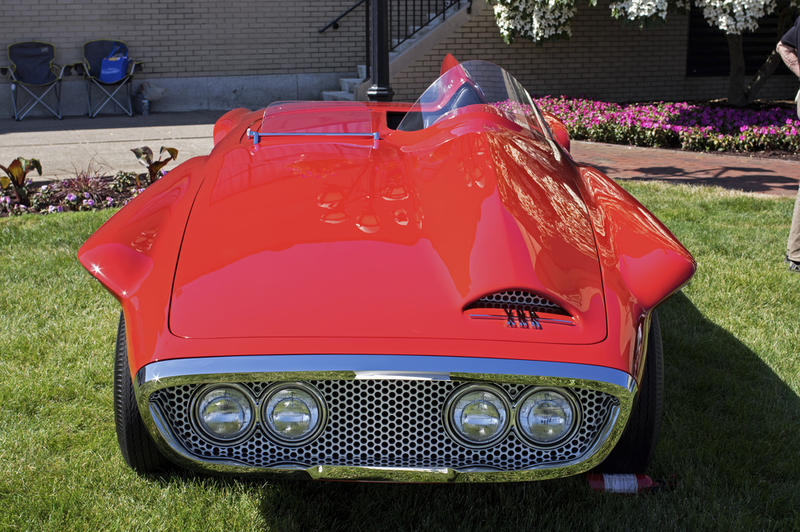 Shutterstock
Shutterstock
The XNR got 250 horsepower and the engine was an inline-six, with a steel body mounted onto a Plymouth Valiant Chassis. Unfortunately, the vehicle was too costly to be sent to mass production.
Ferrari 250 Shooting Brake
Production cost: $400,000*
Italian team Giotti Bizzarrinni and Giovanni Volpi created the Ferrari 250 GT. The car was nicknamed “La Camionnette” or “little truck” by the French press and “Breadvan” by the English press. The nickname stemmed from its exterior design because it resembled a shooting-brake with its roofline that extended into the rear.
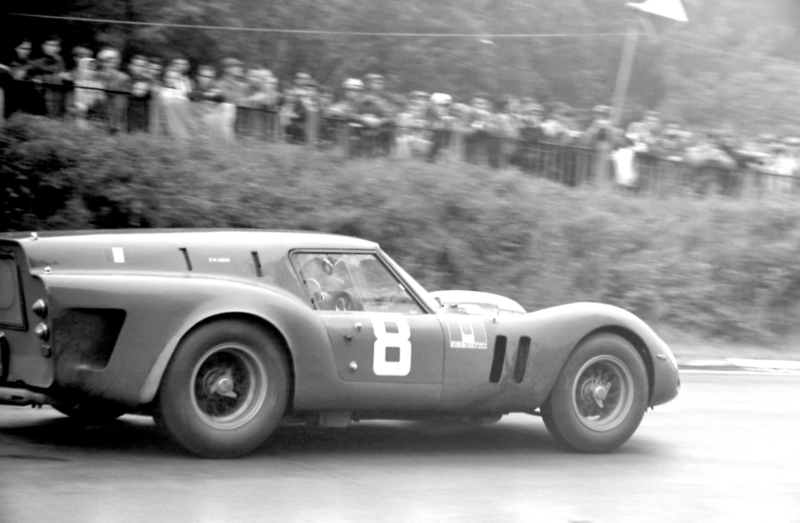 Getty Images Photo by GP Library/Universal Images Group
Getty Images Photo by GP Library/Universal Images Group
This avant-garde exterior design was based on the Kamm aerodynamic theory, which Bizzarrinni applied with the help of a car body specialist, Piero Drogo. Inside, the engine was a Ferrari 250 Tip-168 V12, and the transmission was a 250 SWB four-speed. The strange little model weighed in at 2,061.3 pounds at the ’62 Le Mans race.
Ferrari 512S Modulo
Production cost: $100,000*
Paolo Martin is responsible for the Ferrari 512S Modulo design. This space age-looking model debuted at the Geneva Motor Show in 1970 and featured a canopy roof that allowed both driver and passenger to enter the cabin. The wheels were partially-covered, and the V12 under the hood reached up to 550 horsepower.
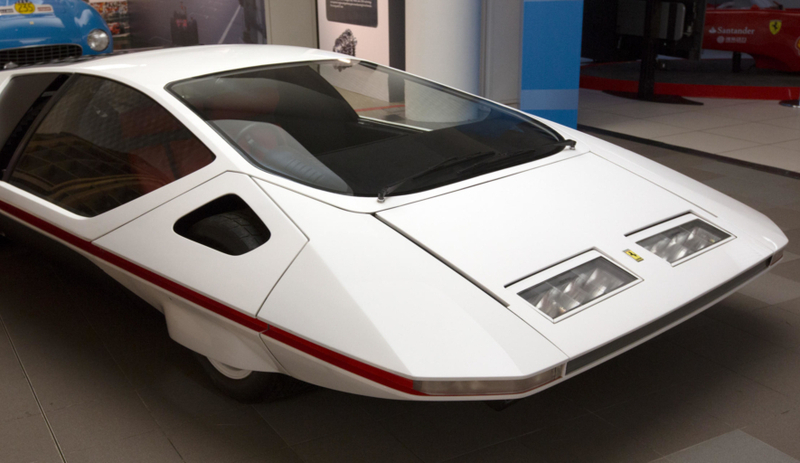 Alamy Stock Photo
Alamy Stock Photo
The Modulo’s low-profile structure aided in its speed capabilities. The top speed recorded for the Modulo was 220 miles per hour, and it could go from 0 to 60 in 3 seconds flat! The Modulo was of course not mass-produced but was sold privately to James Glickenhaus in 2014.
